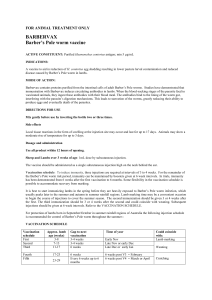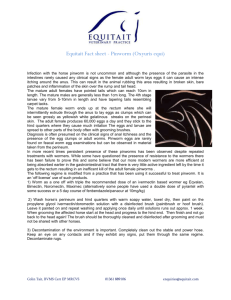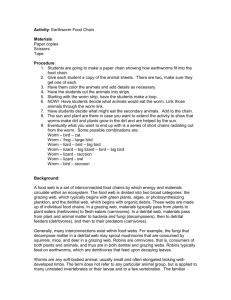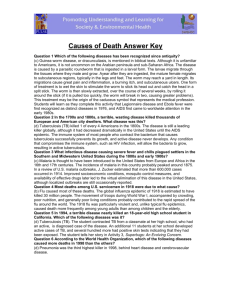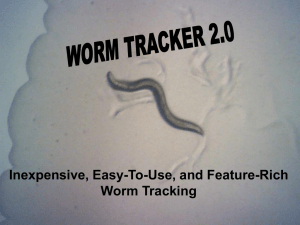Farm Newsletter - Struthers & Scott
advertisement
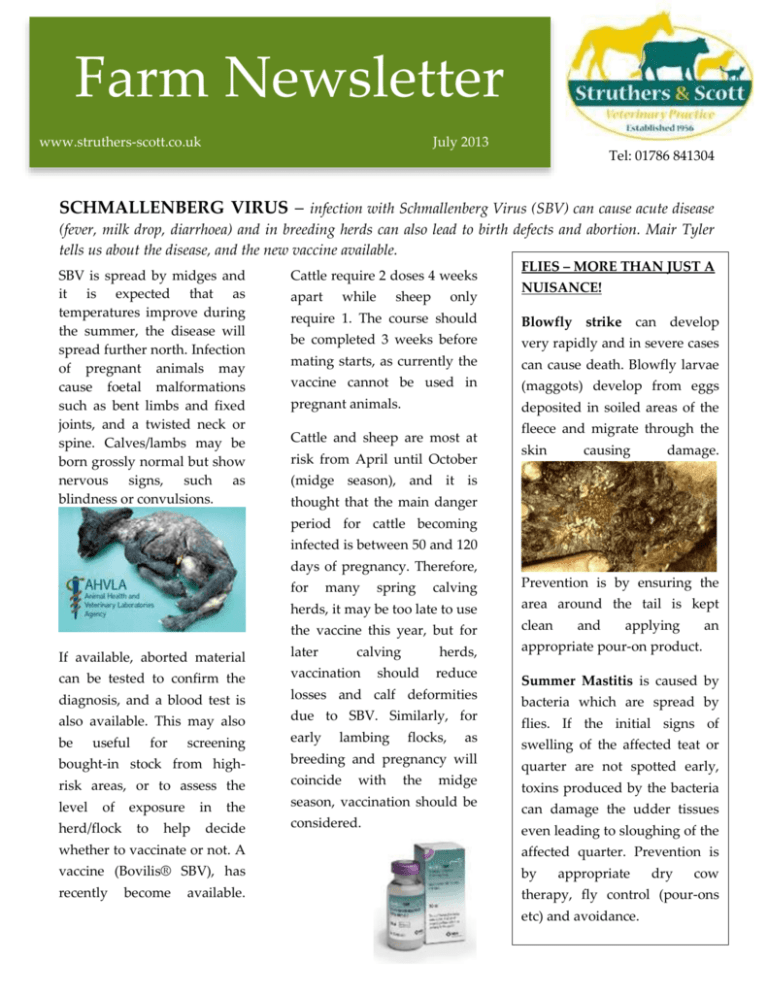
Farm Newsletter www.struthers-scott.co.uk July 2013 Tel: 01786 841304 SCHMALLENBERG VIRUS – infection with Schmallenberg Virus (SBV) can cause acute disease (fever, milk drop, diarrhoea) and in breeding herds can also lead to birth defects and abortion. Mair Tyler tells us about the disease, and the new vaccine available. SBV is spread by midges and it is expected that as temperatures improve during the summer, the disease will spread further north. Infection of pregnant animals may cause foetal malformations such as bent limbs and fixed joints, and a twisted neck or spine. Calves/lambs may be born grossly normal but show nervous signs, such as blindness or convulsions. Cattle require 2 doses 4 weeks apart while sheep only FLIES – MORE THAN JUST A NUISANCE! require 1. The course should Blowfly strike can develop be completed 3 weeks before very rapidly and in severe cases mating starts, as currently the can cause death. Blowfly larvae vaccine cannot be used in (maggots) develop from eggs pregnant animals. deposited in soiled areas of the Cattle and sheep are most at risk from April until October fleece and migrate through the skin causing damage. (midge season), and it is thought that the main danger period for cattle becoming infected is between 50 and 120 days of pregnancy. Therefore, calving Prevention is by ensuring the herds, it may be too late to use area around the tail is kept the vaccine this year, but for clean If available, aborted material later appropriate pour-on product. can be tested to confirm the vaccination diagnosis, and a blood test is losses and calf deformities also available. This may also due to SBV. Similarly, for be early for useful for screening many spring calving herds, should lambing reduce flocks, as bought-in stock from high- breeding and pregnancy will risk areas, or to assess the coincide level season, vaccination should be of herd/flock exposure to in help the decide with considered. the midge and applying an Summer Mastitis is caused by bacteria which are spread by flies. If the initial signs of swelling of the affected teat or quarter are not spotted early, toxins produced by the bacteria can damage the udder tissues even leading to sloughing of the whether to vaccinate or not. A affected quarter. Prevention is vaccine (Bovilis® SBV), has by recently therapy, fly control (pour-ons become available. appropriate etc) and avoidance. dry cow PROBLEMS WITH WORMS? - A heavy worm burden can have various effects: from poor growth rates and delayed finishing, to scour, ill-thrift and death. Effective worm control should limit the exposure of susceptible lambs to significant burdens of infective worm larvae on the pasture. Tom Southall AVOIDING RESISTANCE IN-HOUSE WORM EGG COUNTS NOW AVAILABLE! WORM CORRECTLY! Worm control involves appropriate management of available grazing and strategic dosing with wormers. Around this time of year, pasture will potentially be carrying the greatest number of infective worms, though exactly when this peak risk occurs is dependent upon many factors, in particular the weather. And with increasing cases of wormer-resistance, it is important to try and only use wormers when they are needed – and to make sure that they are used correctly. Worm Egg Counts are a useful aid in deciding when to worm. Generally, for spring born lambs, samples should be collected every 2-4 weeks from about 6 weeks of age. Pooling samples (see info. box) will allow broader, more reliable samples without significantly increasing cost and we are pleased to now offer this in-house to our clients. weigh animals to avoid underdosing maintain and calibrate the dosing gun drench correctly, with the sheep well restrained always read the products intstructions, and make sure they are stored correctly ‘DOSE AND MOVE’? if clean pasture is available, then dosing lambs at weaning before moving them seems sensible However, it is advisable to allow some wormersusceptible worms to be carried on to the new pasture (to avoid the selection for resistance) This can be done by not dosing the healthiest 10% Speak to one of the vets to learn more. select 10 random individuals and collect a small sample (about 1-2 teaspoons) from each - we can then either test individually or ‘pooled’ if easier, ‘mob samples’ can be collected by gathering a group in the corner of a field for a few minutes then picking up about 10 different 2tsp sized samples into an airtight container when they move samples must be fresh (<1hour from being passed) as old samples can give falsely low results store in airtight containers (sample pots or sandwich bags) and keep cool hand in to the practice for testing asap (<48hrs max) results should be available within 24hrs DO DRENCH CHECKS! pooled worm egg counts should be done after every dosing to check effectiveness. the time to collect samples depends on the wormer used (if unsure, just ask!) - Gp 1 (white): 10-14 days - Gp 2 (yellow): 2-7 days - Gp 3 (clear): 14-16 days IN HOUSE WORM EGG COUNT ONLY £12 FLUKE COMING SOON! Any suggestions /requests for future newsletters, or client evening talks please email tom@struthers-scott.co.uk



